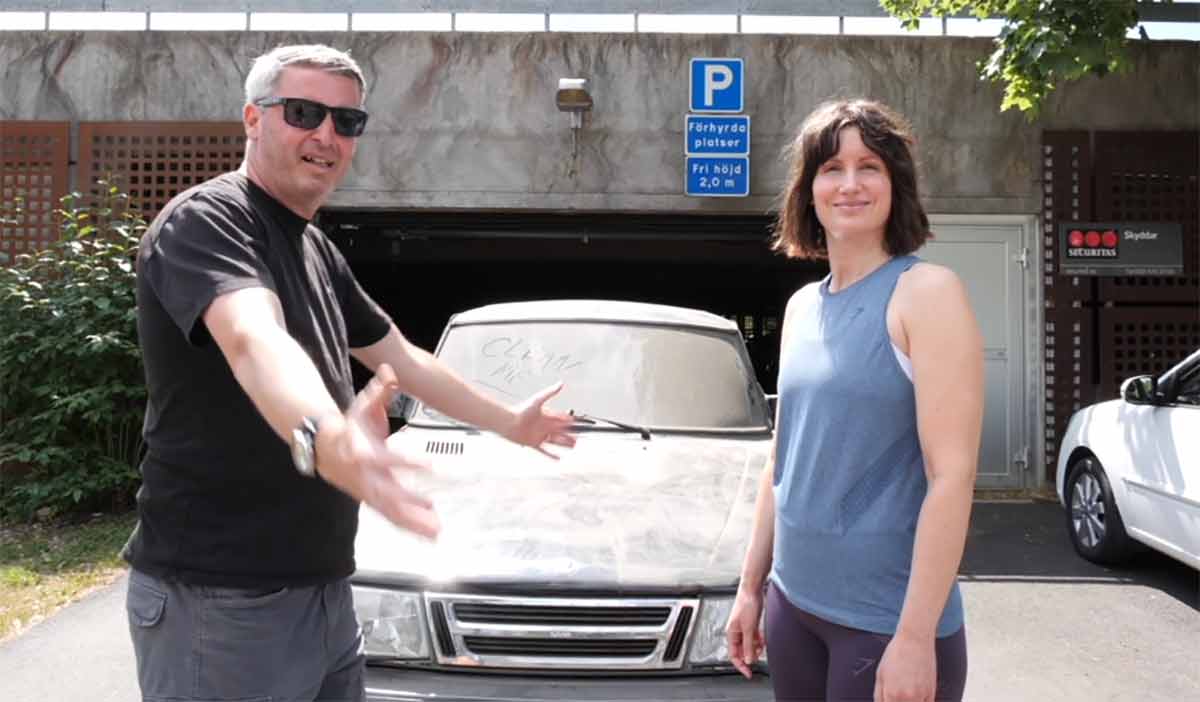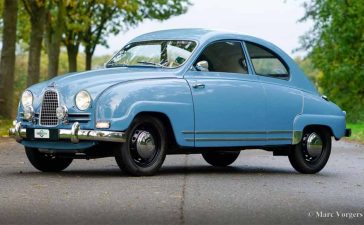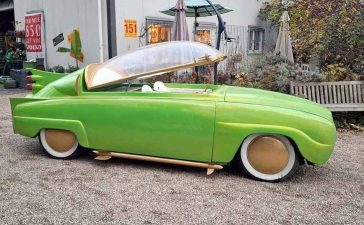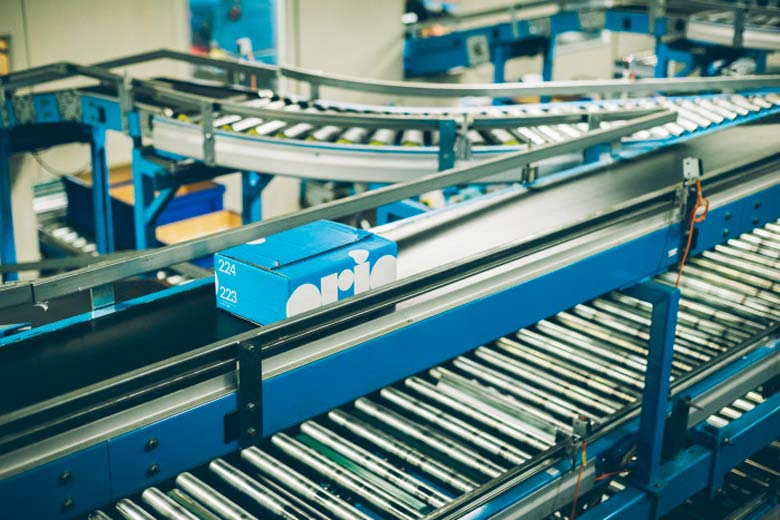Every Saab story starts somewhere – a barn door cracking open, a tarp pulled aside, a memory resurfacing. This one begins not in Trollhättan, but on a small yet dedicated YouTube channel known as Cars of Sweden Live. With just a few thousand subscribers, the channel doesn’t chase flashy studio edits or hyper-polished productions. Instead, it offers something far more valuable to Saab enthusiasts: authentic Swedish car life, filmed as it happens, without scripts, without posturing, and without pretense.
The videos cover everything from salvage rebuilds to barn-find Volvos, forgotten Mercedes sedans, and the occasional supercar. But for anyone who has followed the Saab universe closely, the real highlight was inevitable. One day, the channel’s host stood in front of a dimly lit parking structure, greeting viewers with an unmistakable smile – the smile of someone who knows he’s about to show the audience something special. Behind him, hidden under layers of dust, was a 1987 Saab 900 16-valve Turbo, untouched for 23 years and owned by one family since new.
Cars of Sweden Live describes their mission as offering “man-on-the-street” car reviews and access to cars that most people only dream of encountering. They upload every Sunday at 16:00 CET, but this particular upload quickly became their most SaabPlanet-worthy moment. It captured not only the technical process of reviving a long-stored Turbo but also the emotional weight that comes with a vehicle preserved as a piece of family history.
For Saab enthusiasts around the world, this wasn’t just another “garage find.” It was a rare look into the life of a one-owner, low-mileage, fully preserved 900 Turbo, documented from the moment the garage opened to the moment the car rolled out into the Swedish sun.
The full video can be watched here:
Stepping into the darkness: meeting the 900 Turbo after 23 silent years
The story opens in Hässleholm, where Diana – daughter of the original owner – meets the host in front of a simple row of storage spaces. The atmosphere is unmistakable: a mix of anticipation, dust, and that stillness that only cars in long-term storage possess. Diana explains that the Saab hasn’t left the garage since the early 2000s, effectively frozen in time for 23 years.
The moment the metal door lifts, a familiar silhouette emerges. Even under the dust, the lines are unmistakable: long hood, upright windshield, wraparound rear glass – a classic Saab 900 Turbo, arguably the most definitive Saab shape ever created. “This is my poster car,” the host admits, unable to hide his excitement. For anyone who grew up admiring the brand, the 900 Turbo carried a unique gravity. And this example, still with its original family, offered an authentic glimpse into the past.
As the dust settles, Diana recalls childhood road trips through Europe, often sleeping in the back. Her father even built a custom tent that attached to the rear of the car, turning the hatchback into a miniature camper. That detail alone reveals the mindset of a Saab owner: practicality, ingenuity, and a personal connection to the machine. It’s a story many SaabPlanet readers will recognize – a family creating memories with a car that quietly becomes part of the household identity.
The car’s storage situation had recently become uncertain. The city removed the old row of enclosed garages, leaving the Saab exposed in a partially open parking structure. The family decided it was time to move it before “someone else decided to take an interest.” What they found beneath the dust surprised everyone.
A survivor’s first taste of sun: pulling the Turbo into daylight
Once the Saab is pushed out into the open, the scale of its preservation becomes obvious. The headlights are clear, the bumpers intact, and the famous turbo badge still sits proudly on the hatch. The team quickly notes something unusual: no visible rust. The dry storage and Swedish climate have been kind. Even after two decades of stillness, the car retains its structural strength – a testament to Saab’s galvanization and thick-gauge bodywork.
The host repeatedly remarks on their luck: “You don’t find one of these every day — especially not in this condition.”
They complete Stage One: extraction. The plan is simple – transport it to the workshop, start the cleaning process, attempt a first startup, and evaluate whether a basic inspection is possible.
Before loading the car onto the trailer, the crew performs a cautious initial start attempt. With fresh fuel and basic checks, the engine turns over with little resistance. After a few moments of cranking, the iconic clatter of an early Saab turbo engine echoes across the lot. The sound is unmistakable. Even with stale oil and old hoses, the B202 engine wakes with an unexpectedly smooth idle.
The car is loaded, strapped down, and the resurrection officially begins.

Beneath the covers: an interior frozen in time
Back at the depot, the real surprise awaits – the interior. Saab fans know that tan seats in 1980s models often showed wear early, especially bolsters. But not here. Diana’s father installed custom seat covers within a week of buying the car, professionally stitched and secured in such a way that removing them is a project in itself. Underneath, after an hour and a half of careful cutting, the first seat is revealed.
What emerges is astonishing.
The seat looks factory new. No fading. No wrinkles. Not even the soft polishing marks that appear after years of sliding in and out. The crew realizes they’re likely the first people to see these seats exposed since 1987.
Then comes the next detail:
- The carpets are covered with protective plastic – original.
- The door sills were wrapped in custom-fitted vinyl to prevent scratches.
- Additional plastic mats covered every surface subject to wear.
“It’s been mummified,” the host says, half-joking but fully correct. This isn’t preservation. It’s automotive archaeology.
Piece by piece, the covers come off. The cabin slowly transforms from a dusty relic into a pristine snapshot of the car’s very first week on the road.
Polish, patience, and precision: restoring the 900 Turbo’s shine
With the interior revealed, attention turns to the bodywork. Under the dust, the paint is dull and flat from decades without wax or sunlight. The team begins the slow process of polishing – not a quick buff, but hours of manual correction, layer after layer.
As the polishing begins, the host notes something SaabPlanet readers know well: the sturdy paint Saab applied during the era, especially on black cars, often responds beautifully to correction. After the first pass, the hood begins to reflect the workshop lights. After the second pass, the fenders regain depth. The transformation continues until, eventually, the car looks like a well-cared-for survivor rather than a long-forgotten artifact.
But honesty remains:
- There are minor blisters near the door edges.
- A soft dent sits high on the roof.
- The right-side door panel carries a subtle impression.
- The wheels have light curb marks but remain original and perfectly presentable.
These are not flaws – they are part of a 36-year narrative, the physical record of a car that lived, then slept, then lived again.
The original wheels – iconic Aero alloys wrapped in period Pirellis – still look stunning.
Mechanical awakening: engine, turbo, and drivability
With cosmetics progressing, the mechanical work begins. There is no attempt to pretend this car is ready to drive 500 km home. The team is clear: “This engine needs a proper service before it can be used.”
The basics are checked:
- Oil: old but clean
- Fluids: low but stable
- Belts: dry but intact
- Ignition: functional
- Battery: replaced
- Fuel system: flushed and refreshed
Once everything is safe enough for a controlled test, the Saab is gently driven outside. Only two or three hundred meters — nothing more. But even that short trip confirms the fundamentals are sound. The turbo spools lightly, the gearbox engages smoothly, and the brakes, though aged, function consistently.
Yet the team emphasizes caution: Any car that sits for 20+ years must undergo a full inspection — especially a turbocharged Saab. Rubber components, vacuum lines, and turbo seals all age even without mileage. Before the next owner enjoys boost under full load, the car deserves a detailed mechanical revival.
The final reveal: preparing the 900 Turbo for auction
After two to three weeks of work, the Saab is ready. The dust is gone, the paint gleams, and the cabin looks untouched by time. The custom camping tent remains part of the story, though not installed for the video. The mileage sits at just 44,000 km, a figure nearly impossible to find on any classic 900 Turbo today.
Their conclusion is clear: This is a collector’s car. Not because it is perfect, but because it is real — an unrepeatable combination of originality, low mileage, family ownership, and preservation.
The car is scheduled to appear on Bilweb Auctions, with bidding expected to be fierce among Saab purists who have spent years searching for exactly this kind of survivor. A fully preserved 1987 Turbo with a documented one-family history does not come up often – not in Sweden, not in Europe, not anywhere.
For the Saab community, this is more than a listing. It’s a reminder of why these cars inspire such loyalty. They are not status symbols or collectibles in the classic sense. They are companions, road trip partners, and slices of Scandinavian engineering philosophy brought to life in steel and turbocharged air.
Why this story resonates so deeply with Saab enthusiasts
Saab stories are rarely about horsepower alone. They are about people – families who grew up with these cars, engineers who built them, and enthusiasts who preserve them long after the company’s closure. This 1987 Saab 900 Turbo embodies everything that keeps the community alive:
- Ingenuity, shown through the handmade rear tent
- Longevity, proven by its rust-free survival
- Passion, reflected in a father who wrapped every interior surface to protect it
- Nostalgia, carried in Diana’s memories of sleeping in the backseat
- Engineering brilliance, in a B202 turbo engine that wakes after 23 silent years
Cars of Sweden Live captured all of this with honesty and simplicity – no dramatic sound effects, no exaggerated reactions. Just a car, a family, and a story waiting to be told.











